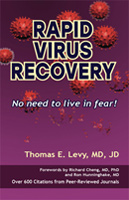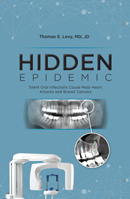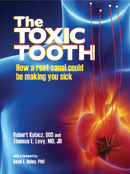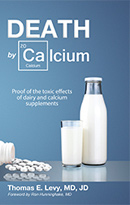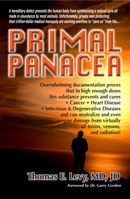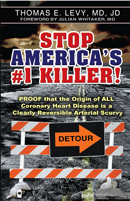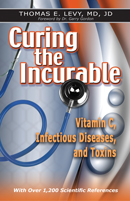Can a dental infection cause a massive heart attack?
July 3, 2019 by Dr. Thomas LevyFor literally hundreds of years now, the idea that a dental infection could seed, initiate, and promote virtually all chronic degenerative diseases has been hotly debated in the medical and dental communities, often with much more passion and hyperbole than with science.
This "debate" continues today, and nothing encapsulates this focal infection link between the mouth and the body better than the root canal-treated tooth. And while the root canal-treated tooth is certainly not the only significant source of dental infection and toxicity, it is easily the most devastating one – as you will soon see.
Conventional dentistry refuses to inform patients about the risk of a dental infection from a root canal procedure
The "success" of a root canal-treated tooth for a given individual depends on the goal of the root canal procedure. If the goal of a root canal procedure is to retain a pain-free natural tooth for both esthetic and chewing function, then the root canal procedure is frequently ‘successful.’
Considered in strictly a dental/mechanical context, few procedures in dentistry are so beneficial. Typically very painful and grossly infected teeth are restored to a mechanically sound state, free of obvious infection and any significant symptoms.
Without the root canal procedure, the only real option, in modern dentistry, for most such teeth is extraction – an option that most dentists and patients want to avoid at all costs.
However, when the health of the rest of the body is the paramount consideration, few, if any procedures in dentistry or medicine, can undermine good health and shorten longevity as effectively as root canal-treated teeth. Both the dentist and the patient should fully realize the potential negative impact of having a root canal procedure in order to make the best and most informed decision for a treatment plan.
The true nature of a root canal procedure revealed
The only way to make an informed decision on whether to have a root canal treatment on a painful, infected tooth is to understand fully the nature of the procedure, as well as to be familiar with an increasing volume of scientific literature directly examining its clinical and pathological impact throughout the body.
The “old issue” of the root canal-treated tooth being the classic example of a focal infection causing dramatic pathology throughout the body now has very strong, new support in the dental and medical literature.
With rare exception, the root canal procedure is performed to relieve acute or chronic pain resulting from an inflamed and infected pulp and root tip. The procedure itself then involves removing the pulp tissue with all the associated nerves, blood vessels, and connective tissue, widening and shaping the root canal space, followed by the insertion of a filling material into the hollow canal space. Also, identifiable abscesses at the root tip are drained as part of the procedure.
The literature now clearly demonstrates that while the root canal procedure might acutely remove most, if not all of the infected pulp tissue, it simply never sterilizes it. Residual bacteria will always remain in the accessory canals, dentinal tubules, or remnants of pulp tissue.
This really should not come as a surprise, as the physical matrix (pulp) on which the immune system depends to gain access to the infection inside the tooth has been removed. The microscopic dentinal tubules then harbor whatever pathogens were present indefinitely, typically producing a steady supply of enormously potent toxins that result whenever oral aerobic organisms remain trapped in an anaerobic environment, like the inside of the tooth.
And to make matters worse, the venous and lymphatic drainage at the base of the root canal-treated tooth remain intact, meaning that every time the individual chews on such a tooth, pathogens and toxins are injected directly into the circulation, just as a hypodermic needle might inject its contents directly into the vein.
Scientific research that remains unseen by most dental patients
Recent studies have been compelling in establishing the link between root canal-treated teeth and coronary heart disease, and the totality of the studies make it hard to avoid the clear-cut conclusion that root canal-treated teeth are one of the primary contributors to the cause and progression of heart disease in many individuals. Even the Journal of the American Dental Association, in 2009, reported that individuals with root canal-treated teeth had more coronary heart disease than those without root canal-treated teeth.
Apical periodontitis, an advanced form of gum disease that share the same pathogen profiles as are seen in root canal-treated teeth, has been found to seed those same pathogens directly into the coronary arterial wall, directly into the atherosclerotic plaque, and directly into the clots that acutely form to cause coronary artery obstruction and heart attack. Also, studies have now demonstrated the significant role that toxins from those same pathogens play in the evolution of atherosclerosis leading to heart attack.
Would you bet your health on the mindset of conventional dentistry?
It does not appear that any amount of data will convince the vast majority of conventionally-trained dentists, performing root canal procedures on a regular basis, that this procedure is one of the primary reasons for a patient eventually sustaining a heart attack – even years later. However, the data is what the data is.
Examine it, try to find a dentist who is at least open to discussing these issues, and make as informed a decision as possible before proceeding with a root canal procedure, if you feel it must be done. The root canal procedure is not the only "option" for an infected, painful tooth, and you need to be fully aware of all of these options. You need to save your health, and your life, as well as your smile.
References:
1. Haraszthy et al. (2000) Identification of periodontal pathogens in atheromatous plaques. Journal of Periodontology 71:1554-1560. PMID: 11063387
2. Mattila et al. (2005) Dental infections and cardiovascular disease: a review. Journal of Periodontology 76:2085-2088. PMID: 16277580
3. Caplan et al. (2006) Lesions of endodontic origin and risk of coronary artery disease. Journal of Dental Research 85:996-1000. PMID: 17062738
4. Caplan et al. (2009) The relationship between self-reported history of endodontic therapy and coronary artery disease in the Atherosclerosis Risk in Communities Study. Journal of the American Dental Association 140:1004-1012. PMID: 19654253
5. Willershausen et al. (2014) Association between chronic periodontal and apical inflammation and acute myocardial infarction. Odontology 102:297-302. PMID: 23604464
6. Ott et al. (2006) Detection of diverse bacterial signatures in atherosclerotic lesions of patients with coronary artery disease. Circulation 113:929-937. PMID: 16490835 Pessi et al. (2013) Bacterial signatures in thrombus aspirates of patients with myocardial infarction. Circulation 127:1219-1228. PMID: 23418311
More articles:
June 22, 2013 | Liposome-Encapsulated Glutathione
July 9, 2013 | Root canals are a primary cause of chronic disease
June 27, 2013 | Calcium, the Toxic Supplement
July 28, 2013 | Vitamin C With Vaccinations
August 3, 2013 | Avoiding Digestive Toxicity
August 10, 2013 | The disease causing dangers of high iron levels
August 19, 2013 | Vitamin C better than chemotherapy
September 2, 2013 | The marketing myth of ’vitamin C complex’
September 18, 2013 | Cardiologist speaks truth about cholesterol and statins
October 2, 2013 | Reverse shingles with vitamin C
October 14, 2013 | The effective prevention and treatment of radiation exposure
October 29, 2013 | Undiagnosed scurvy causes widespread disease
November 19, 2013 | Eliminate lead toxicity by consuming vitamin C
November 29, 2013 | New study says high fat diet is healthy
January 1, 2014 | Osteoporosis is much more than calcium deficiency
February 21, 2014 | Vitamin C is the 'muscle' of the immune system
March 11, 2014 | Reversing disease with the 'multi-C' protocol
April 6, 2014 | The dangers of magnesium deficiency
April 11, 2014 | Exposing the truth about liposomal nutrients
July 13, 2014 | Best nutrients to have in your ‘one a day’ supplement
August 3, 2014 | Surprising solution for Ebola virus
October 19, 2014 | Can natural protocols be an effective treatment for Ebola?
November 16, 2014 | Medical warning: Gluten allergies affect everyone
December 5, 2014 | Holistic dentistry pioneer Dr. Hal Huggins dies at 77 but his legacy will live forever
December 23, 2014 | Can a dental infection cause a massive heart attack?
January 29, 2015 | Most cardiologists shocked to discover the true cause of heart attacks
September 2, 2015 | The number one cause for 90 percent of all heart attacks
February 15, 2016 | The most popular vitamin C myths exposed
February 27, 2016 | How to effectively treat viral infections, including Ebola and Zika
March 14, 2016 | The never-ending war against vitamin C
May 22, 2017 | Vitamin C and sepsis: The genie is now out of the bottle
June 22, 2019 | Most cardiologists shocked to discover the true cause of heart attacks
July 3, 2019 | Can a dental infection cause a massive heart attack?
September 30, 2019 | Medical warning: Gluten allergies affect everyone
March 19, 2020 | Best nutrients to have in your 'one a day' supplement
October 30, 2020 | The dangers of magnesium deficiency
About NaturalHealth365
Dr. Levy regularly contributes brief articles of interest to the NaturalHealth365 website, which can accessed here: www.naturalhealth365.com.


